Last time in our look at Keeping Up Appearances, we saw Harold Snoad making a load of fake films for Onslow’s telly. But Onslow doesn’t just enjoy watching the offcuts of Snoad’s location shoots. He also likes a bit of sport. Real, actual clips of motor racing and horse racing, not fake stuff.
But we get a little more specific than than that, surely?
Motor Racing
Let’s take a look at the second episode of Series 1, “The New Vicar”, broadcast on the 5th November 1990.
This is the British Touring Car Championship 1990. Or even more exactly, Round Two at Donington Park, which took place on the 29th April 1990, and was broadcast on BBC2 during Sunday Grandstand on the 6th May 1990.1
Footage from this race is – slightly unbelievably – sitting nicely on YouTube. The section we see in Keeping Up Appearances above is at 6:14 in the below video:
And so, for the final proof:
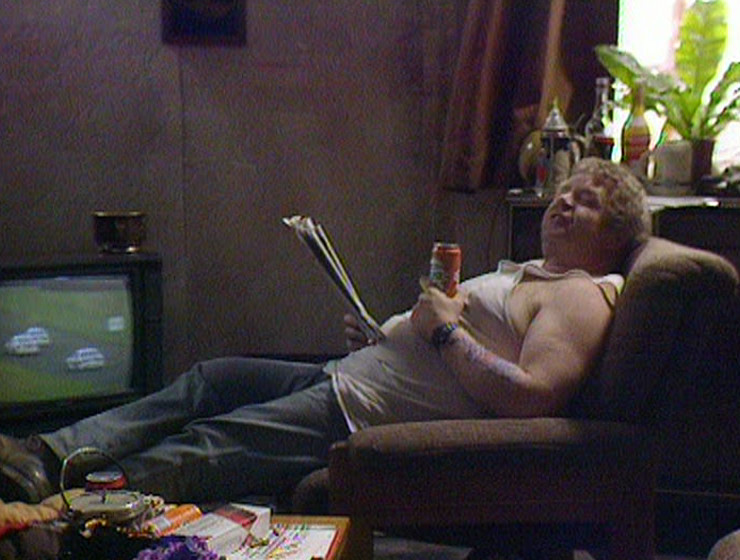
Keeping Up Appearances
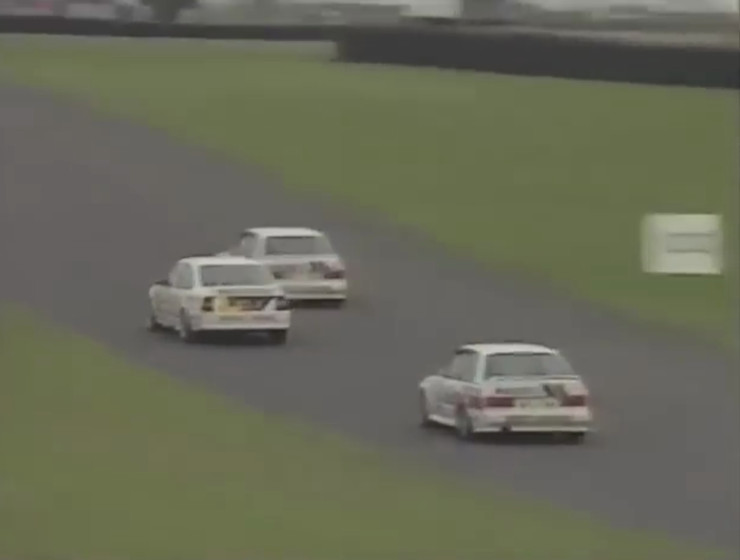
Sunday Grandstand
The overscan on Onslow’s television really is dreadful.
The pilot of Keeping Up Appearances was recorded on the 15th April 1990; “The New Vicar”, where this footage first appears, was actually the next episode recorded, on the 7th October 1990. So oddly enough, this race hadn’t even happened when the first episode was recorded, but was already a few months old by the time this second episode was made.
As per Snoad’s fake films, this footage wasn’t just used once; whenever Onslow is watching motor racing throughout the entire five series of Keeping Up Appearances, it’s always the above piece of footage used.
Seen in: “The New Vicar” (1.2), “A Strange Man” (2.1), “Iron Age Remains” (3.2), “A Celebrity for the Barbecue” (4.3)
Heard in: “Daisy’s Toyboy” (1.5), “Singing for Emmet” (2.7)
Horse Racing
The penultimate episode of Series 1, “Daisy’s Toyboy”, was broadcast on the 26th November 1990, and it’s particularly heavy with sports material. As well as the motor racing above, we also get our first glimpse at some horse racing:
This was at Newbury, and took place on the 17th August 1990; unlike the motor racing, this was actually broadcast live on BBC2 the same day, under the brilliantly prosaic title Golf and Racing.2 This material hasn’t been uploaded to YouTube sadly, but I’ve poked around in some helpful places and viewed the material for myself to make sure.
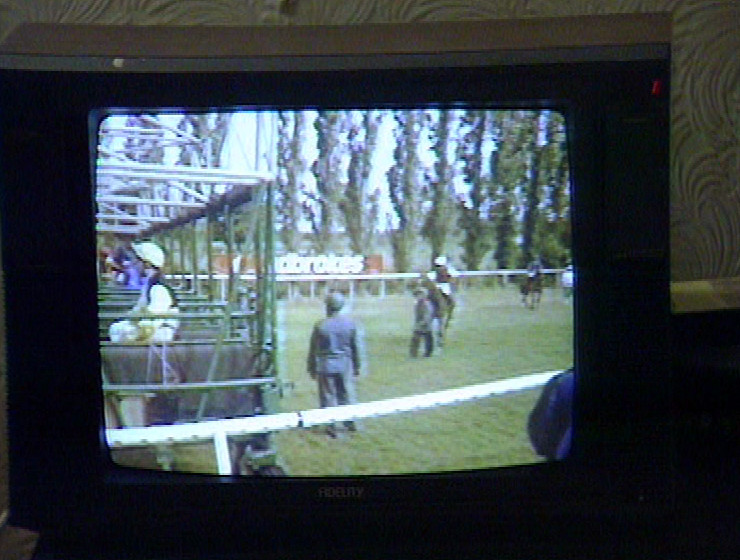
Keeping Up Appearances
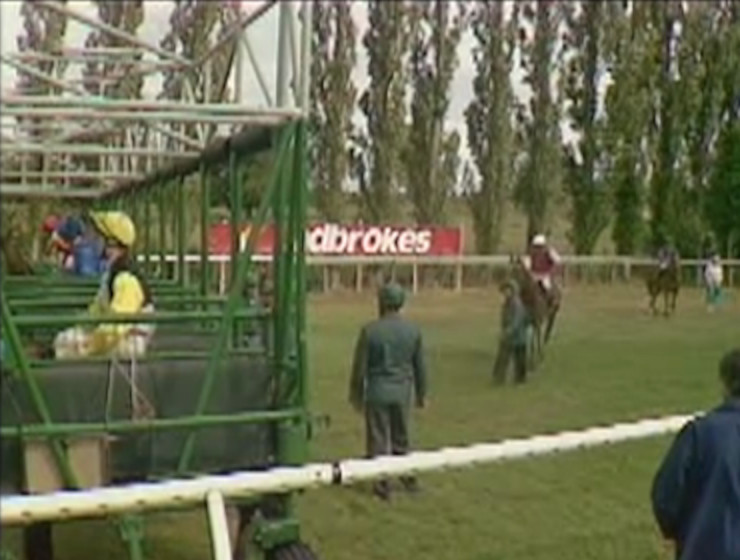
Golf and Racing
This same racing footage is also used in the pub in the final scene of the episode. It’s a little more difficult to tell, as the image on the pub television is so small, but I’ve matched up the commentary on the original footage, and it’s definitely correct:

Keeping Up Appearances
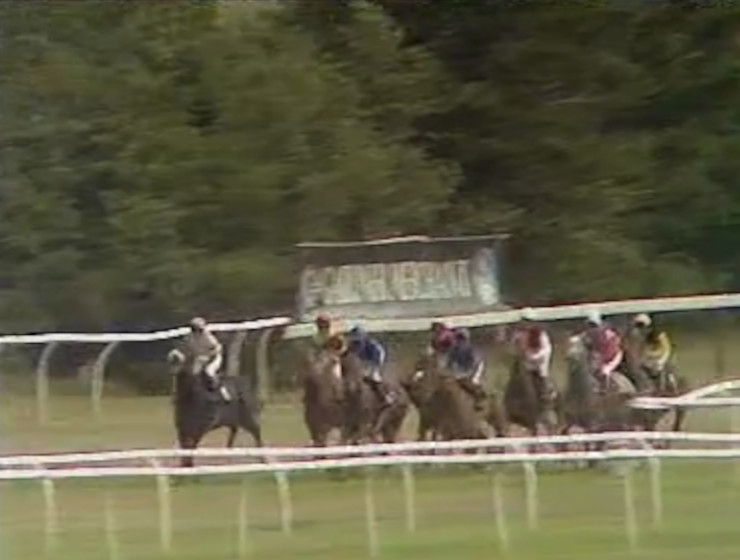
Golf and Racing
The same applies to this horse racing footage as with the motor racing; the original footage actually transmitted between the pilot and second episode of Keeping Up Appearances recorded. And much like the motor racing material, whenever Onslow is watching horse racing in the show, it’s always footage from the above programme used. Which makes sense.
After all, who would ever bother to check?
Seen in: “Daisy’s Toyboy” (1.5), “The Candlelight Supper” (2.3), “A Picnic for Daddy” (2.10), “Iron Age Remains” (3.2), “The Commodore” (4.4)
Heard in: “Onslow’s Birthday” (2.6), “The Art Exhibition” (3.6), “The Mayor’s Fancy Dress Ball” (5.2)
We’re not quite finished with Onslow’s telly. Next time, in the third and final piece, we’ll be looking at the material he watches which I couldn’t quite track down… but maybe you can.
Thanks to J. Wallace for the information about the production of the British Touring Car Championship. A very early version of this post was first published in the August issue of my monthly newsletter.
For more information on the production of the BTCC around this time, check out Steve Rider’s book My Chequered Career: Thirty-Five Years of Televising Motorsport (Haynes, 1992). It goes into a lot of detail, but this is the key bit about the delayed transmission:
“Each Championship would consist of about ten rounds, and the budget would not come close to putting a live outside broadcast unit at all ten […] locations. The decision was taken that the coverage would not be live, instead it would be post-produced; in other words several cameras recording remotely would generate the coverage, it would all be edited together over the following couple of days and the commentary put on as the last component.
However, the BBC, for all its facilities, could not handle such an operation, so the responsibility for mounting the coverage and delivering the final broadcast version would go to an independent producer. Not only that, but the independent producer or its agent would also have the responsibility of generating the budget, because the BBC would only pay a nominal £1,000 per race, feeling that its side of the bargain was covered by providing the Grandstand airtime and a four million audience.”
Rider talks in great detail about how the new Grandstand coverage, which started in 1987, was a coup for British motorsport… and about the compliance obstacles it involved in terms of sponsorship. You can well imagine that they must have been quite pleased to get a spot in Keeping Up Appearances, no matter how small. Onslow watching the BTCC as a normal activity is surely exactly the kind of thing they were after. ↩
In other words: a bit like a mini-Grandstand, but only covering two sports. This kind of programme has disappeared entirely from the BBC; programmes now only cover a single sport, and two sports require two separately-billed programmes. ↩

6 comments
J. Wallace on 30 September 2024 @ 12pm
Of course, presenting shows as highlights helped too, as well as getting it on Onslow’s telly (I swear he wears a truck racing merchandise baseball cap at one point, too). When they ‘did’ get funds to do it live, people say how processional it could be, and viewing dwindled.
I would add to this that Steve’s work as a packager extended to ITV’s F1 rights as MACH1 (Meridian, Anglia and CHrysalis). They paid a damn sight more than a grand for it, though.
As I recall, the BBC wouldn’t let him out of his contract, so Steve hastily recruited and trained Jim Rosenthal in the subtleties of Motorsport to make things work. The book I pointed John to is available to borrow from the Internet archive, and is certainly an interesting read from the viewpoint of getting something that commercial on the BBC.
Simon Tyers on 30 September 2024 @ 12pm
Steve Rider tells of how Murray Walker would take a few hours on the Monday watching the edit of a BTCC race and making detailed notes about everything, and then he’d go to the dubbing suite and make it sound entirely live in one take so skilfully people were before long turning up to watch him do it.
Rob Keeley on 1 October 2024 @ 11am
Great work again, John.
That’s a young Jonny Lee Miller there, outside the door. More recently seen playing John Major in The Crown!
Martin Fenton on 4 October 2024 @ 10pm
“ The overscan on Onslow’s television really is dreadful.”
Zoomed to hide on-screen timecode?
Will M on 15 October 2024 @ 2pm
Regarded by many motorsport fans as the golden era of BTCC (it even spawned a couple of Playstation games!), having the racing accessible on Saturday afternoon Grandstand would’ve helped viewing figures. BTCC is still on the go, albeit the formula has changed to be bodykitted hatchbacks rather than standard looking “dad cars”, still good racing but not particularly well marketed by ITV and shuffled off to ITV4 (with Steve Ryder at the helm). Having Onslow watch it was probably highlighting the passive audience that Grandstand brought to it.
Joe Dredd on 23 October 2024 @ 1pm
I hope Onslow won a few bets, seeing as he should know all the results after the first time round.
Also, if they let those horses and drivers start earlier, they wouldn’t have to go so fast.
Comments on this post are now closed.